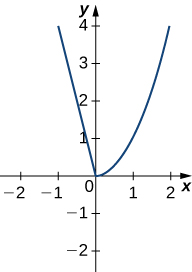3.10: Chapter 3 Review Exercises
( \newcommand{\kernel}{\mathrm{null}\,}\)
Exercises 1 - 4
True or False? Justify the answer with a proof or a counterexample.
- Every function has a derivative.
- Answer
- False
- A continuous function has a continuous derivative.
- A continuous function has a derivative.
- Answer
- False
- If a function is differentiable, it is continuous.
Exercises 5 - 6
Use the limit definition of the derivative to exactly evaluate the derivative.
- f(x)=√x+4
- Answer
- f′(x)=12√x+4
- f(x)=3x
Exercises 7 - 14
Find the derivatives of the given functions.
- f(x)=3x3−4x2
- Answer
- f′(x)=9x2+8x3
- f(x)=(4−x2)3
- f(x)=esinx
- Answer
- f′(x)=esinxcosx
- f(x)=ln(x+2)
- f(x)=x2cosx+xtanx
- Answer
- f′(x)=xsec2x+2xcosx+tanx−x2sinx
- f(x)=√3x2+2
- f(x)=x4sin−1(x)
- Answer
- f′(x)=14(x√1−x2+sin−1x)
- x2y=(y+2)+xysinx
Exercises 15 - 17
Find the indicated derivatives of various orders.
- First derivative of y=x(lnx)cosx
- Answer
- dydx=cosx⋅(lnx+1)−x(lnx)sinx
- Third derivative of y=(3x+2)2
- Second derivative of y=4x+x2sinx
- Answer
- d2ydx2=4x(ln4)2+2sinx+4xcosx−x2sinx
Exercises 18 - 19
Find the equation of the tangent line to the following equations at the specified point.
- y=cos−1(x)+x at x=0
- y=x+ex−1x at x=1
- Answer
- y=(2+e)x−2
Exercises 20 - 21
Draw the derivative of the functions with the given graphs.


- Answer
-

Figure 3.10.3: A piecewise function is plotted with two distinct segments: For negative x-values, the function is a horizontal line at y=−4, extending to the left. There is an open circle at (0,−4). For positive x-values, the function is a diagonal line with a positive slope, starting from the origin (0,0), though there is an open hole there, and increasing as x increases.
Exercises 22 and 23
These exercises concern the water level in Ocean City, New Jersey, in January, which can be approximated by w(t)=1.9+2.9cos(π6t), where t is measured in hours after midnight, and the height is measured in feet.
- Find and graph the derivative. What is the physical meaning?
- Find w′(3). What is the physical meaning of this value?
- Answer
- w′(3)=−2.9π6. At 3 a.m. the tide is decreasing at a rate of 1.514 ft/hr.
Exercises 24 and 25
Consider the wind speeds of Hurricane Katrina, which affected New Orleans, Louisiana, in August 2005. The data are displayed in a table.
| Hours after Midnight, August 26 | Wind Speed (mph) |
|---|---|
| 1 | 45 |
| 5 | 75 |
| 11 | 100 |
| 29 | 115 |
| 49 | 145 |
| 58 | 175 |
| 73 | 155 |
| 81 | 125 |
| 85 | 95 |
| 107 | 35 |
Wind Speeds of Hurricane KatrinaSource: news.nationalgeographic.com/n..._timeline.html.
- Using the table, estimate the derivative of the wind speed at hour 39. What is the physical meaning?
- Estimate the derivative of the wind speed at hour 83. What is the physical meaning?
- Answer
- −7.5. The wind speed is decreasing at a rate of 7.5 mph/hr


